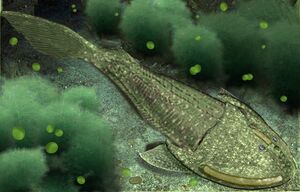پاليوزوي
| Paleozoic | ||||||||||||||||
|---|---|---|---|---|---|---|---|---|---|---|---|---|---|---|---|---|
| 541.0 ± 1.0 – 251.902 ± 0.024 Ma | ||||||||||||||||
| Chronology | ||||||||||||||||
| ||||||||||||||||
| Etymology | ||||||||||||||||
| Name formality | Formal | |||||||||||||||
| Alternate spelling(s) | Palaeozoic | |||||||||||||||
| Usage information | ||||||||||||||||
| Celestial body | Earth | |||||||||||||||
| Regional usage | Global (ICS) | |||||||||||||||
| Time scale(s) used | ICS Time Scale | |||||||||||||||
| Definition | ||||||||||||||||
| Chronological unit | Era | |||||||||||||||
| Stratigraphic unit | Erathem | |||||||||||||||
| Lower boundary definition | Appearance of the Ichnofossil Treptichnus pedum | |||||||||||||||
| Lower boundary GSSP | Fortune Head section, Newfoundland, Canada 47°04′34″N 55°49′52″W / 47.0762°N 55.8310°W | |||||||||||||||
| GSSP ratified | 1992 | |||||||||||||||
| Upper boundary definition | First appearance of the Conodont Hindeodus parvus. | |||||||||||||||
| Upper boundary GSSP | Meishan, Zhejiang, China 31°04′47″N 119°42′21″E / 31.0798°N 119.7058°E | |||||||||||||||
| GSSP ratified | 2001 | |||||||||||||||
The Paleozoic (or Palaeozoic) Era (النطق: /ˌpæl.i.əˈzoʊ.ɪk,_ʔi.oʊʔ,_ˌpeɪ.li.əʔ,_ʔli.oʊʔ/ pal-ee-ə-ZOH-ik, --ee-oh-, pay-lee-, --lee-oh-;[1][2] from the Greek palaiós (παλαιός), "old" and zōḗ (ζωή), "life", meaning "ancient life"[3][4]) is the earliest of three geologic eras of the Phanerozoic Eon. It is the longest of the Phanerozoic eras, lasting from , and is subdivided into six geologic periods (from oldest to youngest): the Cambrian, Ordovician, Silurian, Devonian, Carboniferous, and Permian. The Paleozoic comes after the Neoproterozoic Era of the Proterozoic Eon and is followed by the Mesozoic Era.
The Paleozoic was a time of dramatic geological, climatic, and evolutionary change. The Cambrian witnessed the most rapid and widespread diversification of life in Earth's history, known as the Cambrian explosion, in which most modern phyla first appeared. Arthropods, molluscs, fish, amphibians, synapsids and diapsids all evolved during the Paleozoic. Life began in the ocean but eventually transitioned onto land, and by the late Paleozoic, it was dominated by various forms of organisms. Great forests of primitive plants covered the continents, many of which formed the coal beds of Europe and eastern North America. Towards the end of the era, large, sophisticated diapsids and synapsids were dominant and the first modern plants (conifers) appeared.
The Paleozoic Era ended with the largest extinction event in the history of Earth, the Permian–Triassic extinction event. The effects of this catastrophe were so devastating that it took life on land 30 million years into the Mesozoic Era to recover.[5] Recovery of life in the sea may have been much faster.[6]
Geology
The Paleozoic era began with the breakup of the supercontinent of Pannotia[7][8] and ended with the assembly of the supercontinent of Pangaea.[9] The breakup of Pannotia began with the opening of the Iapetus Ocean and other Cambrian seas and coincided with a dramatic rise in sea level.[10] Paleoclimatic studies and evidence of glaciers indicate that Central Africa was most likely in the polar regions during the early Paleozoic. The breakup of Pannotia was followed by the assembly of the huge continent Gondwana (). By mid-Paleozoic, the collision of North America and Europe produced the Acadian-Caledonian uplifts, and a subduction plate uplifted eastern Australia. By the late Paleozoic, continental collisions formed the supercontinent of Pangaea and created great mountain chains, including the Appalachians, Ural Mountains, and mountains of Tasmania.[9]
Periods of the Paleozoic Era
There are six periods in the Paleozoic Era: Cambrian, Ordovician, Silurian, Devonian, Carboniferous (alternatively subdivided into the Mississippian Period and the Pennsylvanian Period), and the Permian.[11]
Cambrian Period
The Cambrian spanned from 541 to 485 million years ago and is the first period of the Paleozoic era of the Phanerozoic. The Cambrian marked a boom in evolution in an event known as the Cambrian explosion in which the largest number of creatures evolved in any single period of the history of the Earth. Creatures like algae evolved, but the most ubiquitous of that period were the armored arthropods, like trilobites. Almost all marine phyla evolved in this period. During this time, the supercontinent Pannotia begins to break up, most of which later became the supercontinent Gondwana.[12]
Ordovician Period

See also
References
- ^ قالب:Dictionary.com
- ^ قالب:MerriamWebsterDictionary
- ^ "Paleozoic". Online Etymology Dictionary.
- ^ The term "Palaeozoic" was coined by the British geologist Adam Sedgwick (1785–1873) in: Sedgwick, Adam (1838). "A synopsis of the English series of stratified rocks inferior to the Old Red Sandstone – with an attempt to determine the successive natural groups and formations". Proceedings of the Geological Society of London. 2 (58): 675–685. ; see p. 685.
- ^ Sahney, S. & Benton, M.J. (2008). "Recovery from the most profound mass extinction of all time". Proceedings of the Royal Society B: Biological Sciences. 275 (1636): 759–65. doi:10.1098/rspb.2007.1370. PMC 2596898. PMID 18198148.
- ^ http://www.economist.com/node/16524904 The Economist
- ^ Scotese, C. R. (2009). "Late Proterozoic plate tectonics and palaeogeography: a tale of two supercontinents, Rodinia and Pannotia". Geological Society, London, Special Publications. 326 (1): 68. Bibcode:2009GSLSP.326...67S. doi:10.1144/SP326.4. S2CID 128845353. Retrieved 29 November 2015.
- ^ Murphy, J. B.; Nance, R. D.; Cawood, P. A. (2009). "Contrasting modes of supercontinent formation and the conundrum of Pangea". Gondwana Research. 15 (3): 408–20. Bibcode:2009GondR..15..408M. doi:10.1016/j.gr.2008.09.005. Retrieved 20 December 2019.
- ^ أ ب Rogers, J.J.W.; Santosh, M. (2004), Continents and Supercontinents, Oxford: Oxford University Press, p. 146, ISBN 978-0-19-516589-0
- ^ Dalziel, I. W. (1997). "Neoproterozoic-Paleozoic geography and tectonics: Review, hypothesis, environmental speculation". Geological Society of America Bulletin. 109 (1): 16–42. Bibcode:1997GSAB..109...16D. doi:10.1130/0016-7606(1997)109<0016:ONPGAT>2.3.CO;2.
- ^ "The Paleozoic Era". www.ucmp.berkeley.edu. University of California Museum of Paleontology. 2011.
- ^ University of California. "Cambrian". University of California.
Further reading
- British Palaeozoic Fossils, 1975, The Natural History Museum, London.
- "International Commission on Stratigraphy (ICS)". Home Page. Retrieved September 19, 2005.
